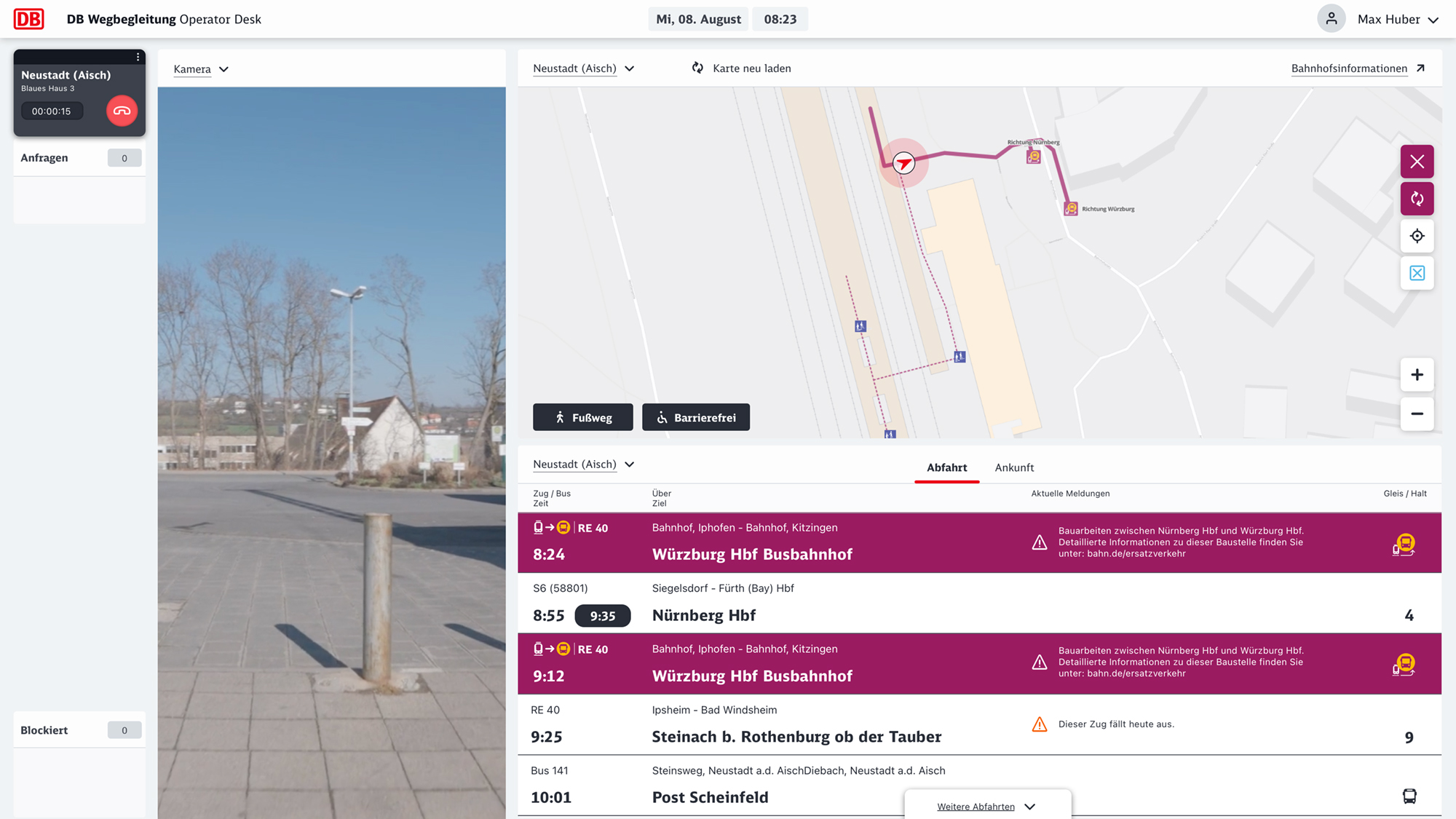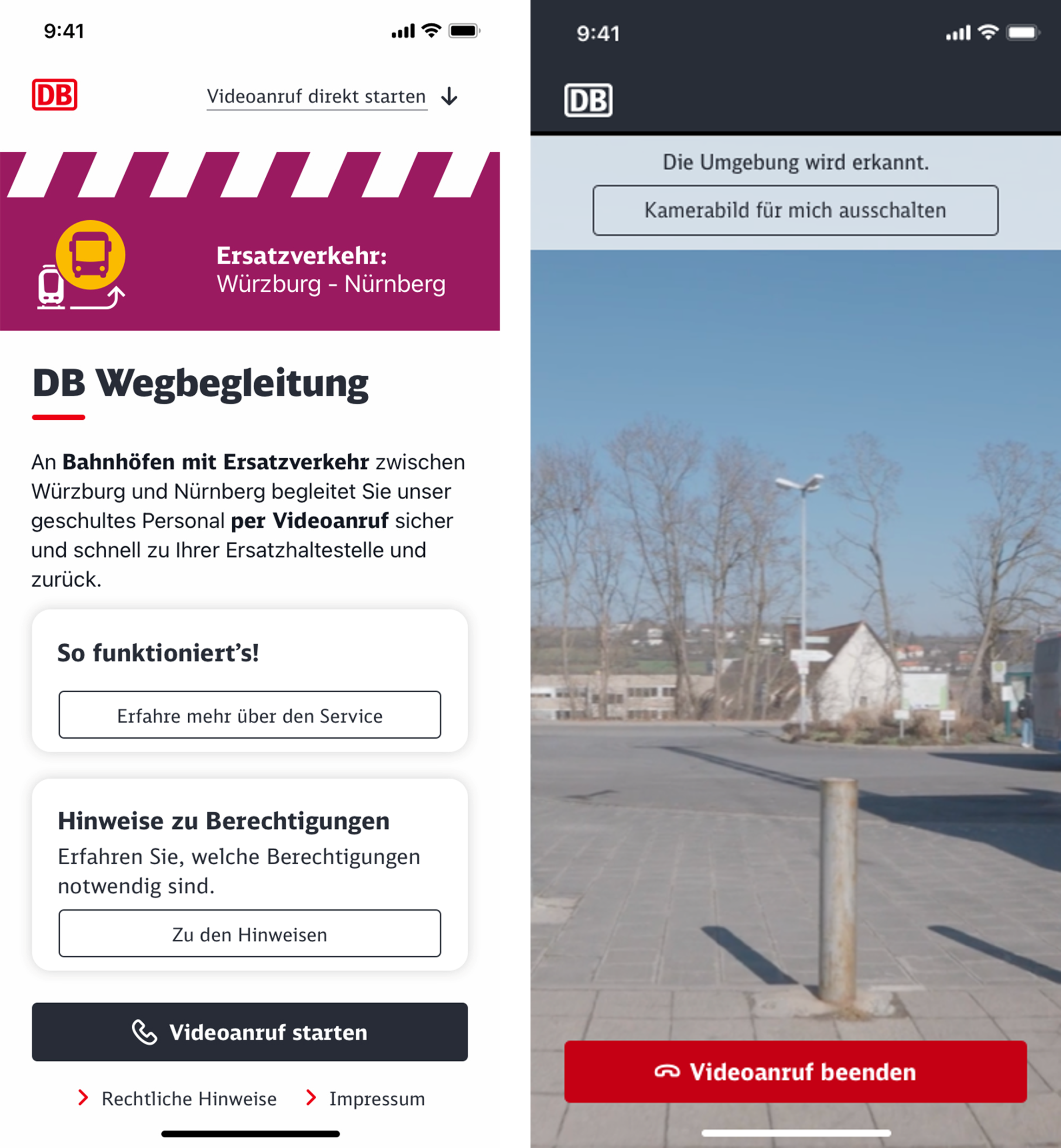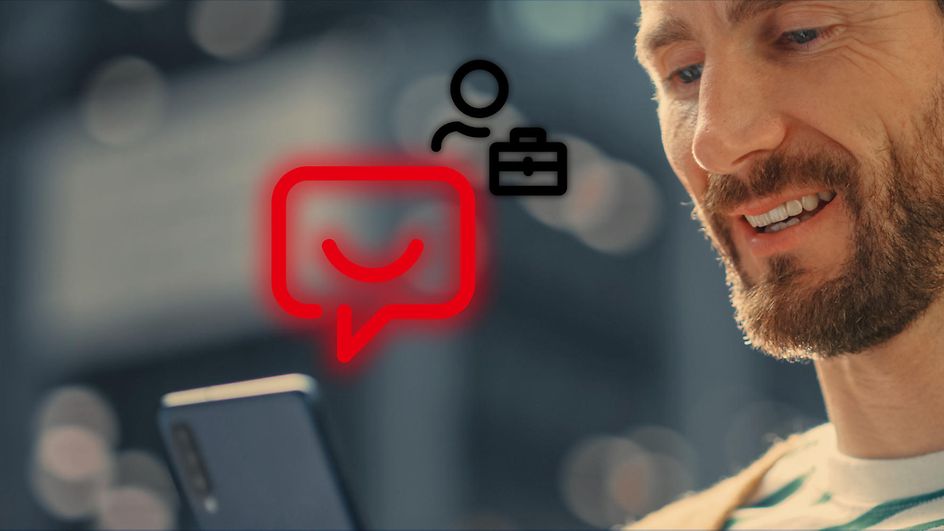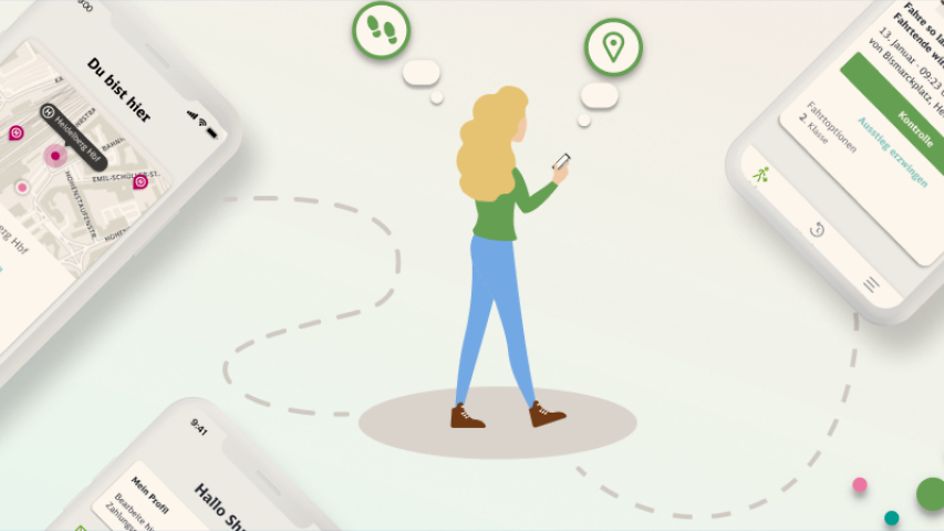Guidance and support with using the rail replacement service
Article: DB Wegbegleitung helps blind and visually impaired travellers reach their destination despite line closures and indirect routes
01/2024 – Through focused, agile collaboration, DB Regio and DB Systel have implemented an accessibility solution in an extremely short time. Feedback from both participants and users on DB Wegbegleitung has been entirely positive. The solution enables blind or visually impaired travellers to remain mobile despite line closures and rail replacement services.
For blind and visually impaired travellers, the train is the most important means of transport for independent travel. However, to keep pace with future demand, it is important that Deutsche Bahn upgrades large parts of the rail network. Whilst this will improve journey times and increase the number of travel connections in the long term, for now, it does mean some disruption due to construction works and rail replacement services. For blind or visually impaired people, such changes and diversions present a particular challenge. During construction work on the line between Nuremberg and Würzburg, the DB Wegbegleitung pilot project used smartphones to guide travellers safely from the platform to the rail replacement service. The project demonstrated that fast, straightforward digital solutions can also be a significant support for a small group of travellers.
Helping visually impaired and blind travellers find their way despite station disruptions
Train stations already offer a range of facilities to help travellers with disabilities find their way around independently. Thanks to tactile paving (grooves on the floor) and loudspeaker departure announcements, amongst other things, many visually impaired travellers are today able to travel confidently and independently on their regular, familiar routes. A signposted change of route to a replacement bus stop, on the other hand, presents a major challenge. Employees from Deutsche Bahn's customer dialogue department can help here. It is there to accompany travellers in need of assistance through the station and help them change trains. However, to coordinate the colleagues on site, the service must be requested one day in advance. The idea behind DB Wegbegleitung, therefore, was to make spontaneous travel easier.
Lisa Heise from DB Regio is responsible for product innovation and product management for passengers with reduced mobility and passenger information. She was looking for additional support for the rail replacement service, especially for travellers with disabilities. "The aim is to facilitate independent travel," Lisa explains. This is because regional transport tends to be used more spontaneously than long-distance transport and is a good option for travellers with disabilities due to the large amount of space available.
The Nuremberg-Würzburg line was one rail line that, during 2023, was hit by varying route disruptions over an extended period due to construction works. Between some stops, travellers had to use the replacement bus. Deutsche Bahn took these planned line closures as an opportunity to try out hundreds of ideas as part of its "New rail replacement service" programme and develop new measures to make the rail replacement service as straightforward as possible. For example, screens and clear colour markings direct passengers from the platform to the replacement stops and often also state the distance to be walked. New buses featuring bicycle racks offer travellers maximum convenience.
"We wanted to also offer a service as part of the rail replacement service that was specifically intended for passengers with reduced mobility. You would usually think of wheelchair accessibility in this regard. So I thought it would be good to try out a solution aimed at a different target audience. The focus was on making the entire travel experience better."

Pilot project up and running in a few weeks
The entire project took just 13 weeks to set up. Not only did it represent a new approach with great potential, but it was also up and running extremely quickly. From the very beginning, the DB Wegbegleitung project was an ideal combination of timing and opportunity. Lisa Heise and the DB Regio team wanted to make the upcoming rail replacement service as accessible as possible and offer an enhanced service: "For this project, we really wanted to add something extra," Lisa Heise recalls. This was what prompted the collaboration with Marcus Sümnick's team from DB Systel.
Marcus has been working at DB Systel for years on various traveller accessibility solutions. For example, he and his team developed a prototype app that helped blind and visually impaired travellers automatically detect open doors on trains or at stations using a smartphone camera. This gave him the idea for a video-based guide to help people find their way around the station. He knew from visually impaired colleagues at work that it is relatively common to ask friends and family for help in finding their way by video call. In cooperation with Marvin Küfner, responsible for requirements management for digital products at DB Regio, DB Systel and DB Regio thus embarked on this tightly scheduled project.
Marcus recalls how both sides were focused on the key aspects of the project right from the start. Requirements could thus be finalised swiftly and in an agile manner without excessive documentation, but ensuring that the core benefit was kept in sight at all times. The specific tasks for the development team and UX designers were soon quickly identified. No registration is required, for example. This was one of the features that was not essential. Callers only have to agree to the terms of use and can speak to the employees immediately.

Integrating existing solutions instead of developing new components was also a great help during implementation as it was faster and more scalable. Both the internal website and views (customer service centre and user) of DB Wegbegleitung are entirely web based. "We essentially customised the underlying standard technology to suit our needs," Marcus explains. DB Systel chose Azure Communication Services for the key video transmission component. This is the same video transmission technology used for Microsoft Teams video conferences. "At no time did we have to worry about running out of resources". In this use case, the technical basis not only enables video and audio transmission, but also GPS tracking and an integrated waiting area if there is currently no operator available.
Together, we have shown that we are good at agile collaboration and are gradually making positive progress. We have built a solution without any false expectations, which has been well received by travellers and actually helps."

DB Wegbegleitung is more than an IT project. It is about bringing people together. It was therefore essential to find motivated colleagues who wanted to contribute to improving the mobility of people with visual impairments. The team were already in contact with the local customer service and DB Streckenagent colleagues about the planned rail replacement service in Bavaria. They were immediately willing to take on the role of operator in the pilot project, guiding callers through the station from the computer. At short notice, all the necessary information was collected, material prepared and training sessions held with test persons so that the operators themselves could see test calls in action at the station.
DB Wegbegleitung in practice
The DB Wegbegleitung pilot project ran during the line closure from August to September 2023. If blind or visually impaired travellers at the station were looking for someone to escort them to the replacement stop, they could simply scan a QR code that they found on a flyer, which of course was written in Braille. This opened the website with the video call for travellers and connected through to the customer service centre. As this was a localised pilot project with minimal lead time, there was hardly any time to inform the other travellers. Nevertheless, there were numerous opportunities to present the idea to the target audience and to carry out tests with them to obtain specific feedback.
Marcus remembers that some of the test groups were initially sceptical about whether it would work. These testers included representatives from interest groups for people with visual impairments, for example. After experiencing it in practice, however, the scepticism was soon overcome, with many surveyed expressing a desire for the service to be rolled out nationwide. The feedback from the customer service advisors was also extremely positive. They were impressed by the new service and immediately saw the added value for travellers.
Several concerns arose during preparations for the project, "A lot of theoretical questions were asked, such as: how is it legal or who is liable?" Marcus recalls. The colleagues from the customer service centre were concerned that passengers might fall while being accompanied at the station, for example. "During the training with sight-impaired people, it was clear that the travellers were highly adept at dealing with the circumstances. It's much easier than you might think. You don't have to announce every step. What the travellers want above all is guidance and orientation." Direct communication between travellers and employees may appear to be a bottleneck for a scalable digital solution. According to Marcus Sümnick, however, using a central contact centre to accompany travellers is actually much more practical as the staff don't need to be on the ground waiting for the traveller: "People find it easier to travel in situations where they would otherwise say: 'I'm not travelling there', because they have the fallback option of simply making a call."
DB Wegbegleitung to be developed further
Although the pilot project has come to an end, DB Systel continues to work on this solution with a view to making such a service widespread practice. Marcus Sümnick and his team are also experimenting with AI solutions to create further possible use cases or integrate into the existing solution. DB Wegbegleitung demonstrates how travellers with impaired vision can travel safely and independently even under difficult circumstances, such as when having to use a rail replacement service. The project also shows how DB Systel and Group partners can make ideal use of an opportunity that presents itself and implement a project that improves the mobility of travellers in a very short space of time. Blind and visually impaired travellers enjoy greater flexibility and can stay mobile even under exceptional circumstances.



